Rock climbing is a popular activity in the Peak District; particularly on edges such as Stanage or Froggatt. Generally the climbing style is free climbing and the rock is either gritstone or limestone. Climbing has been practised in the Peak District since the late 19th century; James W. Puttrell is generally credited with starting the sport. The first climbing guidebook to the area was Some Gritstone Climbs, by John Laycock, published in 1913. There are over 10,000 routes in the Peak District. One of the most famous Peak District climbers, and a pioneer of many new routes, is Ron Fawcett. The climb known as "Master's Edge", on Millstone Edge, near Hathersage, is a testament to his skill and strength. The climb is graded E7 6c and rises 19m up the near vertical edge.
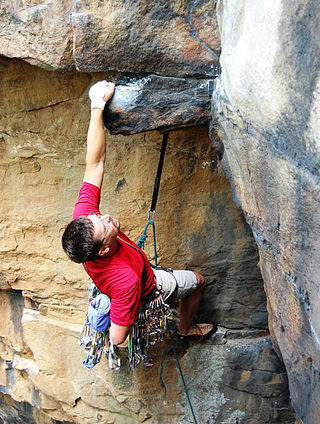
Traditional climbing is a type of free climbing in rock climbing where the lead climber places the protection equipment while ascending the route; when the lead climber has completed the route, the second climber then removes the protection equipment as they climb the route. Traditional climbing differs from sport climbing where the protection equipment is already pre-drilled into the rock in the form of bolts.

Stanage Edge, or simply Stanage is a gritstone escarpment in the Peak District, England, famous as a location for climbing. It lies a couple of miles to the north of Hathersage, and the northern part of the edge forms the border between the High Peak of Derbyshire and Sheffield in South Yorkshire. Its highest point is High Neb at 458 metres (1,503 ft) above sea level. Areas of Stanage were quarried in the past to produce grindstones, and some can still be seen on the hillside—carved, but never removed.

Black Rocks, is a small outcrop of ashover gritstone, between Cromford and Wirksworth in Derbyshire, the Peak District, England. It is an important crag in the history of British rock climbing, and has some of the most extreme climbing routes in Britain, including Gaia E8 6c.

Fair Head or Benmore is a 5-kilometre (3.1 mi) long, 200-metre (660 ft) high, mountain cliff, close to the sea, at the north-eastern corner of County Antrim, Northern Ireland. The cliff's sheer and vertical 100-metre (330 ft) high dolerite rock face is shaped into distinctive vertical columns like organ pipes, which formed 60 million years ago when a sill of igneous rock was injected between horizontal Carboniferous sediments.

Johnny Dawes is a British rock climber and author, known for his dynamic climbing style and bold traditional climbing routes. This included the first ascent of Indian Face, the first-ever route at the E9-grade. His influence on British climbing was at its peak in the mid to late-1980s.
Steve McClure is a British rock climber and climbing author, who is widely regarded as Britain's leading and most important sport climber for a period that extends for over two decades, starting from the late 1990s. In 2017, he created Rainman, Britain's first-ever 9b (5.15b) sport route, and by that stage was responsible for developing the majority of routes graded 9a (5.14d) and above in Britain. Although mainly known for sport climbing, McClure has also been one of the most successful British traditional climbers, and British onsight climbers.
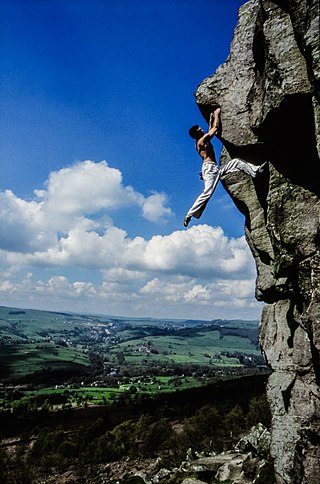
Jerry Moffatt, is a British rock climber and climbing author who is widely considered as being the best British rock climber from the early-1980s to the early-1990s, and was arguably the best rock climber in the world in the mid-1980s, and an important climber in the history of the sport.

Master's Edge is an 18-metre (59 ft) gritstone arête that is a rock climbing route in the "Corners Area" of Millstone Edge quarry, in the Peak District, England. When English climber Ron Fawcett completed the first free ascent of the route on 29 December 1983, it was graded E7 6c, and one of the hardest traditional climbing routes in the world; it remains one of the hardest gritstone climbs.
Lisa Rands is an American rock climber. She is known for her bouldering for which in 2002, she became the first American female to win IFSC World Cup bouldering competitions, and topped the IFSC world boulder rankings in 2002. Rands was the first American female to climb boulders of grade V11 (8A), and V12 (8A+), and was the second-ever female in history to climb a 7C+/8A boulder. As well as making first female ascents (FFAs) of boulders such as The Mandala V12 (8A+), Rands was the first female in history to do an E8-graded traditional climbing route, The End of the Affair.

Clogwyn Du'r Arddu, or "Cloggy", is a north-facing rhyolite set of cliffs located on the northern flank of Snowdon mountain. Cloggy is considered to be one of the best traditional climbing areas in Britain, and has been called "The shrine of British climbing", and a "crucible for the development of most of the finest climbers in Britain and the scene of many of their finest achievements".

In the history of rock climbing, the three main sub-disciplines—bouldering, single-pitch climbing, and big wall climbing—can trace their origins to late 19th-century Europe. Bouldering started in Fontainebleau, and was advanced by Pierre Allain in the 1930s, and John Gill in the 1950s. Big wall climbing started in the Dolomites, and was spread across the Alps in the 1930s by climbers such as Emilio Comici and Riccardo Cassin, and in the 1950s by Walter Bonatti, before reaching Yosemite where it was led in the 1950s to 1970s by climbers such as Royal Robbins. Single-pitch climbing started pre-1900 in both the Lake District and in Saxony, and by the late-1970s had spread widely with climbers such as Ron Fawcett (Britain), Bernd Arnold (Germany), Patrick Berhault (France), Ron Kauk and John Bachar (USA).
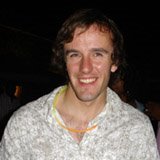
Dave MacLeod is a Scottish rock climber, ice climber, mixed climber, and climbing author. MacLeod was the second-ever person free solo a 8b+ (5.14a) graded route, and for climbing one of the hardest traditional climbing routes in the world.
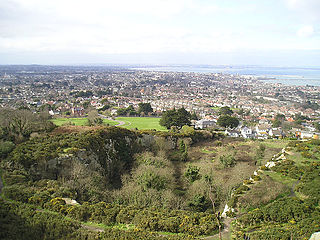
Dalkey Quarry is a long-disused 19th century granite quarry located on Dalkey Hill in the Dublin suburb of Dalkey, which was used to build several large maritime structures in south Dublin. Since passing into public ownership in the early 20th century and becoming part of Killiney Hill Park, it has become one of the most important rock climbing venues in Ireland, with over 350 graded routes, some of which are amongst the hardest single-pitch rock climbs in the country such as Indecent Assault. The climbs are all traditional climbing routes and no bolted sport climbing routes are permitted, although some metal pegs are tolerated on the most extreme routes.
Malcolm Smith is a Scottish rock climber and climbing|competition climber who in 2002, won the bouldering IFSC Climbing World Cup.
Ron Fawcett is a British rock climber and rock climbing author who is credited with pushing the technical standards of British rock climbing in traditional, sport, bouldering and free soloing disciplines, in the decade from the mid-1970s to the mid-1980s, and of pioneering the career of being a full-time professional rock climber. At the end of the 1970s to the early 1980s, Fawcett was widely considered the best and most notable rock climber in Britain.
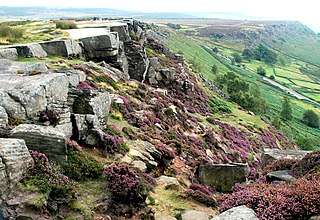
Curbar Edge is a gritstone moorland escarpment above the village of Curbar, in Derbyshire, England and close to the villages of Baslow, Calver, and Froggatt. It is located within the Peak District National Park at an altitude of 958 ft (292 m). It is regarded as a significant location for rock climbing, both regionally and nationally, in terms of both the historical development of the sport and as the location of first ascents.

Burbage Rocks is a gritstone escarpment in South Yorkshire, overlooking the village of Hathersage in the Peak District. The highest point along the escarpment is 429 metres (1,407 ft) above sea level, whilst Burbage Moor rises above to 438 metres (1,437 ft). Burbage Rocks is a southern extension of Stanage Edge. Burbage Brook runs from the northern end of the Burbage Rocks, past the southern end, through Padley Gorge and into the RIver Derwent.
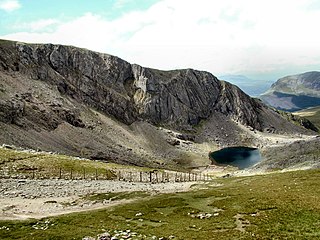
Indian Face is a 45-metre (148 ft) rhyolite rock climbing route on the "Great Wall" of the East Buttress of Clogwyn Du'r Arddu, in Wales. When English climber Johnny Dawes completed the first free ascent of the route on 4 October 1986, it was graded E9 6c or, the first-ever E9-graded route, and was considered one of the hardest traditional climbing routes in the world.
Robert Andrew Pollitt was a British rock climber who was one of the most prominent traditional climbers and sport climbers of the late 1980s and early 1990s. In 1992, after having successfully repeated Punks in the Gym in Australia, the world's first-ever 8b+ (5.14a) graded sport climbing routes, he quit climbing and permanently emigrated to Australia. In 2016, Pollitt published an autobiography, titled Punk in the Gym. He died from a cerebral aneurysm on 13 November 2019.














